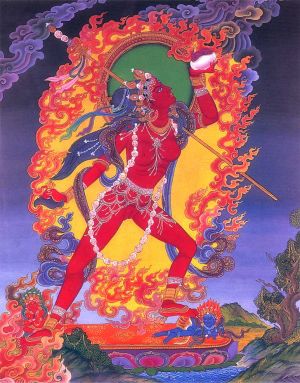Sarvabuddhadakini or Naro Dakini
This lovely and handsome thangka depicts a powerful image of Sarvabuddhadakini or Naro Dakini. Dakinis or Yoginis are skywalkers (a witch or fairy who wanders in the air), in some cases celestial female beings, and sometimes, earthly women who possess supernatural wisdom and powers. They have initiated, taught, and
assisted many great Indian and Tibetan yogis in performing esoteric Vajrayana rituals. For every dhyani Buddha there is an affiliated dakini. A Sarvabuddhadakini, however, has access to all the Buddhas and thus is more powerful. Also known as Naro Dakini, this form of Vajrayogini or Dakini is the preeminent form of
Yogini in the Chakrasamvara and Vajravarahi Tantras. She manifested herself in an initiatory vision to the great Indian Teacher and Mahasiddha Naropa, (A.D. 956-1040) who received teachings from her, and his disciples began calling her Naro Dakini or Vajrayogini Naro Kha Chod or Naro Sky Goers. Moreover she is
patroness of Sakya sect and an acolyte of the Dakini Vajravarahi. The teaching of Naro Dakini is mentioned in the Heruka and Vajravarahi Tantras. She insists that all female beings in the universe are her embodiments or manifestations and thus should be respected, honored and
served without exception. She takes form so that women, seeing enlightenment in female form will recognize their innate divinity and potential for enlightenment. Devotion to her should be expressed as respect for women, while respect for women provides a way of measuring devotion to the goddess. She also promising her blessing to a man who worship her as per instructions mentioned in the Vajrayogini Sadhana.
In the present painting she is dancing in alidha on two personages on a lotus throne. Her body is red, the color of intense emotion and sensuality. She is very youthful looking and is untamed. She has a beautiful shape with large pointed breast and firm nipples. Her face shows the same grimness as her Yogini figure.
With her three eyes she can see past, present, and future. Her eyebrows and hair on her face are flamed-shaped. Her hair is partly upswept in a knot and partly falls in loose on her back. She is wearing a crown of skulls with jewels and bone ornaments on her arms and feet and bone apron on her body. Moreover she is
wearing gold earrings. She is naked except her ornaments, which helps to concentrate one's attention on the expressiveness of her movement. There is an arch-shaped aureole behind her with protective fire fence. Sarvabuddhadakini is holding a vajra chopper in her right hand, there is a skull cup filled with blood that
she is bringing to her lips. On her left shoulder, rests, a magic stick or khatvanga staff. There is a green-skinned double-headed pellet drum (damaru) with a dangling bell, hanging from her khatvanga by a banner, symbolizing her nondual union with Chakrasamvara. The chopper, which has half vajra for handle and
curved iron blade, is actually a butcher's knife. It is also used to cut up corpses that will receive what is called a 'skyburial', in which the cut-up flesh is eaten by vultures and other birds. The ritual meaning in Tantricism lies in the extension of this. It signifies cutting earthly ties and thus crossing into the
liberated state. The kapala or skull cup with blood symbolizes a similar breaking of ties with samsara and also the acceptance of this sacrifice by the Yogini who thereby positive indication that will work with yogi.
The upper corners depict beautiful blue sky with clouds and sun and moon. The middle and foreground portrays lovely mountainous landscape with trees, natural vegetation, waterfalls and lakes etc. There is a wrathful offering at the bottom center. The painting is very much suitable for esoteric practices and rituals.
For example, Naro Dakini may be displayed in a thangka as a manifestation of Vajravarahi. Vajravarahi is the consort of Chakramsavara, a deity around which the current Dalai Lama holds many initiation ceremonies. Naro Dakini is portrayed as pouring blood from a skull-cup into her mouth, the blood trickles from her
mouth and her vagina, symbolising how she is both consuming, and is being consumed, by the feminine principle, wisdom. In the crook of her left arm sits a tantric staff. On the apex of this staff, above a half crossed thunderbolt and a vase of nectar, is impaled a fresh head, a decaying head, a skull and a
thunderbolt. When held by a female, the whole staff represents the masculine principle, compassion.[2] Like all Tibetan symbolism, the imagery represents multiple levels and layers of meanings, such as the representation of the physical universe or an esoteric formula. Thangkas, like sculptures, serve as picture maps detailing how one can achieve enlightenment in just one lifetime.
Select Bibliography
A. Getty, The Gods of Northern Buddhism, Tokyo, 1962
J.C. Huntington and D. Bangdel, The Circle of Bliss: Buddhist Meditational Art, Ohio, 2004
Lokesh Chandra, Transcendental Art of Tibet, Delhi, 1996
Marylin M. Rhie & Robert A.F. Thurman, Wisdom and Compassion: The Sacred Art of Tibet, Thames and Hudson, 1996
Marylin M. Rhie & Robert A.F. Thurman, Worlds of Transformation: Tibetan Art of Wisdom and Compassion, New York, 1999
This description is by Dr. Shailendra K. Verma, whose Doctorate thesis is on "Emergence and Evolution of the Buddha Image (From its inception to 8th century A.D.)".
Source
[[1]]
